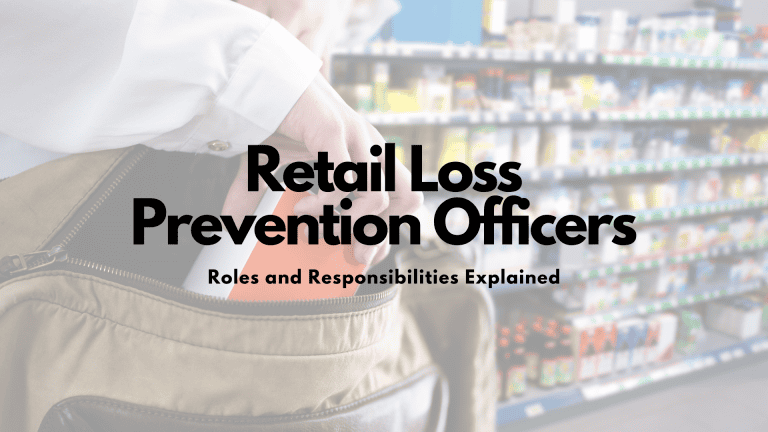Retail Loss Prevention Officers – Roles and Responsibilities Explained

Retail Loss Prevention Officers play a vital role in Canada’s retail industry, working to protect assets and minimize financial loss caused by theft and fraud. These professionals are employed in various retail environments, from small boutiques to large department stores.
They are tasked with the detection and apprehension of shoplifters, conducting internal investigations, and preventing loss through awareness campaigns directed at staff and management.
Their job description extends beyond mere surveillance; Loss Prevention Officers are also responsible for implementing and maintaining security measures throughout the retail premises.
This includes operating security equipment, analyzing loss prevention data, and staying current with the latest retail crime trends to adapt their strategies effectively.
They often work in plain clothes to blend in with the shoppers, which allows them to observe suspicious behaviour more effectively.
In addition to these responsibilities, Retail Loss Prevention Officers in Canada often find themselves liaising with law enforcement agencies to report crimes and provide evidence for prosecution.
Critical to their role is a keen understanding of the laws and regulations surrounding detention and arrest, as well as a strict adherence to company policies and guidelines to ensure that all interventions are carried out legally and ethically.
Excellent communication skills and the ability to remain calm under pressure are indispensable for those looking to succeed in this field.
Retail Loss Prevention Officers Role Overview
Retail Loss Prevention Officers in Canada play a crucial role in safeguarding a store's assets from theft and fraud while ensuring a safe environment for both staff and customers.
Core Responsibilities
- Patrolling: Officers conduct regular on-foot patrols of the retail space to deter theft.
- Surveillance: Monitoring surveillance equipment and identifying suspicious activities.
- Investigation: They investigate incidents of theft and compile evidence for legal proceedings.
- Apprehension: Safely detaining and processing individuals suspected of shoplifting.
- Reporting: Officers maintain detailed logs of incidents and daily activities.
- Training: They also train store staff on loss prevention techniques and protocols.
Work Environment
- In-store: They primarily work inside retail environments, such as shopping centres and standalone stores.
- Team Collaboration: Close cooperation with management and other staff members is essential.
- Shift Variability: Shifts can include days, evenings, and weekends, depending on the store hours.
- Equipment Handling: The use of security devices and software is a regular part of their job.
Importance in Retail
- Asset Protection: Officers are instrumental in protecting the store's physical and financial assets.
- Customer Safety: They contribute to creating a safe shopping experience for customers.
- Profit Preservation: By minimizing losses, they help maintain the profitability of the retail establishment.
Qualifications and Skills
Retail Loss Prevention Officers in Canada require a specific set of qualifications and skills to effectively protect assets and ensure a safe shopping environment. They are expected to come with a certain educational background, demonstrate experience in security or related fields, and possess vital competencies in surveillance and crisis management.
Education and Certifications
| Requirement | Details |
|---|---|
| Minimum Education | High school diploma or equivalent |
| Preferred Education | Post-secondary education in Criminal Justice or related field |
| Certifications | Security Guard License as mandated by provincial regulation and Loss Prevention Course Certification |
| Additional Qualifications | First Aid and CPR certifications |
Candidates typically need a high school diploma as a baseline educational requirement. Post-secondary education in Criminal Justice or related disciplines is preferred for those seeking advanced positions.
Provincial regulations require security personnel, including Retail Loss Prevention Officers, to hold a valid Security Guard License. First Aid and CPR certifications are also common prerequisites.
Experience Requirements
| Position Level | Experience Needed |
|---|---|
| Entry-Level | No prior experience needed, on-the-job training provided |
| Experienced | 1-3 years of experience in loss prevention or retail security |
| Supervisory Roles | 3+ years of experience with leadership responsibilities |
Entry-level positions often do not require previous experience, though on-the-job training is a part of the initial employment phase.
For higher positions, one to three years of experience in loss prevention, security, or a related field is usually necessary. Supervisory roles often require over three years of experience and demonstrable leadership skills.
Key Skills and Competencies
- Observation and Vigilance: Keen attention to detail in monitoring store activities.
- Communication Skills: Effective verbal and written communication.
- Interpersonal Abilities: Professional interaction with staff and the public.
- Problem-solving: Quick thinking and resolution skills in adverse situations.
- Technological Proficiency: Familiarity with security systems and surveillance equipment.
Retail Loss Prevention Officers must have excellent observational skills to detect and prevent theft. They need strong communication skills for reporting incidents and interacting with employees and the public.
Problem-solving aptitude is essential for responding to incidents. Lastly, they should be technologically proficient, comfortable with security systems, and capable of operating surveillance equipment.
Duties and Tasks
Retail Loss Prevention Officers in Canada play a crucial role in protecting company assets by executing a variety of security measures and protocols.
Preventing Theft and Fraud
- Monitor Surveillance: Utilize CCTV systems to oversee the retail environment, watching for signs of shoplifting or internal theft.
- Floor Presence: Maintain a visible presence on the sales floor, deterring potential theft through their attentiveness.
- Tagging Merchandise: Apply anti-theft devices to high-value items to prevent unauthorized removal.
Safety and Risk Management
- Emergency Response: Respond to emergencies, ensuring the safety of staff and customers, and coordinating with emergency services when necessary.
- Hazard Identification: Regularly inspect the premises to identify and mitigate potential safety risks or hazards.
- Incident Reporting: Maintain accurate records of all security-related incidents and safety breaches.
Investigative Procedures
- Conduct Interviews: Interview staff and witnesses in the case of suspected theft or fraud.
- Gather Evidence: Collect and preserve evidence related to theft or other breaches of policy.
- Case Management: Manage ongoing investigations, working closely with law enforcement as needed.
Customer Service
- Assist Customers: Address customer inquiries regarding security measures, providing reassurance without compromising safety protocols.
- Collaboration with Staff: Work with retail employees to enhance security awareness and prevent loss through training and support.
- Conflict Resolution: De-escalate situations involving dissatisfied or disruptive individuals while maintaining professional composure.
Tools and Technology
Retail Loss Prevention Officers in Canada rely on a range of specialized tools and technology to perform their duties effectively. These instruments are essential for surveillance, data analysis, and communication.
Surveillance Equipment
Retail Loss Prevention Officers use a variety of surveillance equipment to monitor retail environments.
- CCTV Systems: A network of cameras placed strategically throughout the retail space.
- Types:
- Dome Cameras
- PTZ (Pan-Tilt-Zoom) Cameras
- Bullet Cameras
- Types:
- Hidden Cameras: Small, unobtrusive cameras used in sensitive areas.
- Common Locations:
- Near cash registers
- In stock rooms
- Common Locations:
- Mirrors: Used both as a deterrent and a means to observe covertly.
- Types:
- Two-way mirrors
- Dome mirrors
- Types:
Security Software Applications
The use of sophisticated software applications is critical for loss prevention.
- Inventory Management: Tracks merchandise and identifies discrepancies.
- Capabilities:
- Real-time inventory tracking
- Automated reorder alerts
- Capabilities:
- Point of Sale (POS) Systems: Monitors transactions and prevents fraudulent activity.
- Features:
- Transaction logs
- Return and exchange monitoring
- Features:
- Data Analysis Tools: Used to analyze trends and predict potential theft.
- Benefits:
- Identification of high-theft times
- Detection of suspicious transaction patterns
- Benefits:
Communication Devices
Effective communication is facilitated by a suite of devices that maintain a constant flow of information.
- Two-Way Radios: Allow for discreet and immediate communication between team members.
- Specifications:
- Multiple channels
- Encrypted communication
- Specifications:
- Smartphones: Used for wider connectivity and access to security applications.
- Uses:
- Mobile patrolling
- Digital reporting
- Uses:
- Ear Pieces: Enable covert communication without alerting potential suspects.
- Advantages:
- Maintains discretion
- Increases responsiveness to incidents
- Advantages:
Legal and Ethical Considerations
Retail Loss Prevention Officers in Canada operate within a framework of laws and ethical guidelines. These officers must balance legal regulations with respect for individual privacy rights.
Canadian Retail Legislation
In Canada, Retail Loss Prevention Officers must be knowledgeable about the Criminal Code of Canada as it pertains to theft, fraud, and property crime.
They should understand specific statutes, such as Section 322 for theft, Section 380 for fraud, and Section 430 for mischief to property.
Provincial regulations also impact their duties. For instance, in Ontario, the Trespass to Property Act allows officers to detain individuals suspected of shoplifting. However, they must conduct detentions with consideration for the individual's legal rights, including the timely involvement of law enforcement.
| Province | Relevant Statute |
|---|---|
| Ontario | Trespass to Property Act |
| Alberta | Petty Trespass Act |
| Manitoba | Petty Trespass Act |
| British Columbia | Trespass Act |
| Saskatchewan | TrespassTo Property Act |
| Nova Scotia | Protection Of Property Act |
| New Brunswick | Trespass Act |
| PEI | Trespass To Property Act |
| Newfoundland & Labradour | Newfoundland & Labrador |
Training and licensing requirements for loss prevention vary by province.
Typically, they must hold a valid security license issued by the provincial regulatory body.
Ethical Standards and Privacy
Ethical standards are paramount in loss prevention.
Officers must conduct themselves with integrity and fairness, ensuring all their actions are justified and within legal bounds.
The Privacy Act and Personal Information Protection and Electronic Documents Act (PIPEDA) dictate how personal information can be collected, used, and disclosed.
Retail Loss Prevention Officers must be cautious not to infringe on an individual's privacy unless required by law.
- Surveillance: The use of cameras must comply with privacy laws; signage should inform customers of surveillance.
- Personal Searches: These should be conducted only by law enforcement unless there is an immediate and clear threat to safety or if explicit consent is provided.
- Detainment: When holding a suspect, officers must respect their rights and only use reasonable force as necessary.
Ethical training programs and clear guidelines are essential tools for officers to avoid overstepping boundaries and ensure they respect individuals' rights and dignity.
Professional Development
Retail Loss Prevention Officers in Canada have avenues for career growth through specialized training and opportunities for advancement.
Training and Certifications
Initial Training: Retail Loss Prevention Officers often begin with a foundational training program that covers the basics of loss prevention, legal aspects of the job, and conflict resolution.
This training may be provided by the employer or through an external training provider.
- Security Guard License: In most Canadian provinces, officers must obtain a security guard license. The requirements for this license typically include a training course and passing a provincial exam.
- Crisis Intervention Training: Courses on how to manage aggressive behaviour and de-escalate situations are beneficial.
- Theft Prevention Certification: Some institutions offer certification programs specifically in theft prevention and loss control.
Continued Education:
- Workshops and Seminars: Regular attendance at industry-specific workshops can keep skills up-to-date.
- Online Courses: E-learning platforms offer flexible options for further education in advanced loss prevention techniques and related subjects.
Advancement Opportunities
Retail Loss Prevention Officers can advance to higher positions through experience, additional training, and a strong performance record.
- Supervisory Roles: With experience, officers may progress to supervisory roles, overseeing a team of loss prevention staff.
- Loss Prevention Manager: Further advancement can lead to managerial positions, responsible for setting strategies and policies to minimize loss.
- Corporate Security: Some may transition into corporate security roles with wider responsibilities including internal investigations and comprehensive security programs.
Pathways:
- Experience in the field is crucial; typically several years of dedicated work are required for promotion.
- Demonstrated leadership and a thorough understanding of retail operations enhance prospects for moving into management.
Employment Outlook
The employment landscape for Retail Loss Prevention Officers in Canada is influenced by current market conditions and anticipated industry growth.
Market Trends
The retail sector in Canada has seen an increase in demand for loss prevention officers due to a rise in retail shrinkage, which includes theft, fraud, and inventory mismanagement. Key drivers for this trend include:
- A shift towards omnichannel retailing requires more sophisticated security measures.
- The increasing cost of retail crime, both in terms of merchandise loss and impact on business reputation.
Moreover, technologies such as CCTV, electronic article surveillance (EAS), and radio frequency identification (RFID) are now standard in the industry. Retailers are looking for officers who are not only adept in traditional surveillance but also in utilizing these advanced tools.
Projected Growth
According to the latest projections, employment opportunities for Retail Loss Prevention Officers are expected to grow. This growth can be attributed to several factors, prominently:
- Expansion of retail businesses and new store openings, creating more positions.
- Greater awareness and investment in loss prevention measures by retail chains.
Financial data indicates that investment in security measures by retailers correlates with an increasing trend to protect assets and reduce losses. Government employment data suggest that job vacancies in this sector will likely continue to increase proportionally to the expansion of the retail industry.
Compensation and Benefits
Retail Loss Prevention Officers in Canada receive a compensation package that includes a competitive base salary and potentially additional benefits.
Salaries typically range from $30,000 to $50,000 annually, depending on the individual's experience, education, and the geographical location of the retail establishment.
In addition to the base pay, these officers may also be eligible for performance bonuses or incentives aimed at rewarding successful loss prevention outcomes.
Overtime pay is common for hours worked beyond the standard workweek.
Benefits can vary by employer, but usually include:
- Health Insurance: Medical, dental, and vision coverage.
- Retirement Plans: Employer-sponsored pension plans or group RRSPs.
- Paid Time Off (PTO): Vacation, personal days, and sick leave.
- Employee Discounts: Reduced prices on store merchandise, often extending to family members.
- Career Development: Access to training programs and opportunities for promotion.
Part-time positions may have prorated benefits or may not include some of the full-time benefits. Employers often offer additional employee assistance programs to support overall well-being.
Working Conditions and Physical Requirements
Retail Loss Prevention Officers in Canada operate in various environments, from small boutiques to large-scale department stores. They work both in plain clothes and uniformed presence, blending with customers or standing out to deter theft.
Work Hours: Often include evenings, weekends, and holidays to coincide with peak shopping times.
Environment: Can be fast-paced, especially during sales events and holiday seasons.
Surveillance: Requires extended periods of observation, which may involve standing or walking for long durations.
Risk Factor: They may encounter confrontation when apprehending suspected shoplifters, which could escalate to physical altercations. Training in conflict de-escalation is provided to mitigate these situations.
Physical Fitness: Important for pursuing suspects if necessary.
Stamina: Needed for potentially lengthy shifts with minimal breaks.
Employment often falls under the purview of the retailer's security protocols, entailing adherence to strict policies and legal frameworks. Observational skills are paramount to identify potential theft threats accurately.
Technology Usage:
- CCTV operation
- Security tagging systems
- Radio communication
Attention to Detail: Is crucial to monitor multiple areas or individuals simultaneously and accurately report incidents.
Last Updated on Jul 5, 2024





